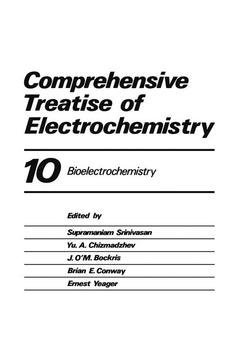Description
Comprehensive Treatise of Electrochemistry, 1985
Volume 10 Bioelectrochemistry
Coordinators: Horsman Peter, Conway Brian E., Yeager E.
Language: English
Subject for Comprehensive Treatise of Electrochemistry:
Keywords
catalysis; chemical reaction; electrochemistry; polymer; semiconductor
Publication date: 10-2011
564 p. · 17.8x25.4 cm · Paperback
564 p. · 17.8x25.4 cm · Paperback
Description
/li>Contents
/li>
1.1. Definition of Terms-Thrombosis, Thromboembolic Disease, Atherosclerosis, and Blood Clotting The terms heart attack or myocardial infarction are more commonly used than thrombosis. The infarct-muscle destruction is simply the end result and thrombosis is the real cause of the heart attack. Thrombosis may be defined as the process of formation of a coalescent or agglutinated solid mass of blood components in the blood stream. Thrombi formed in either arteries or veins often cause occlusion in the vascular system and prevent blood flow. Obstruc to the blood vessel usually occurs at the site where the thrombi deposit. tion Furthermore, thrombi may break loose, travel through the circulating blood stream, and cause obstruction at some distal point of narrowing elsewhere. The mass or thrombus that moves is referred to as an "embolus." The two phenomena are lumped together under the term thromboembolic disease. Thrombosis that reduces blood supply to the heart is the primary factor in heart attacks.
1. The Origin of Electrical Potential in Biological Systems.- 1. Electrical Potential of Biomolecules.- 2. Electrical Potential at Biomolecular Interfaces.- 3. Transmembrane Potential across Cell Membranes.- 4. Molecular Interaction in Biological Systems.- 2. Electrochemistry of Low Molecular Weight Organic Compounds of Biological Interest.- 1. Introduction.- 2. Catecholamines.- 3. Phenothiazines.- 4. ?-Tocopherol and ?-Tocopherylquinone.- 5. Purines.- 6. Conclusions.- References.- 3. Electrochemistry of Biopolymers.- 1. Introduction.- 2. Proteins.- 3. Polysaccharides.- 4. Nucleic Acids.- 5. Nucleoproteins.- 6. Outlook.- References.- 4. Bioelectrocatalysis.- 1. Introduction.- 2. Physicochemical Properties of Enzymes.- 3. Methods of Immobilization of Enzymes.- 4. Electrochemical Properties of Protein Macromolecules and Their Active Groups.- 5. Methods of Conjugation of Electrochemical and Enzymic Reactions.- 6. The Use of Enzymes to Accelerate Electrochemical Reactions.- 7. Mechanism of Bioelectrocatalysis.- 8. Prospects for Practical Utilization of Bioelectrocatalysis.- References.- 5. Electrochemical Aspects of Bioenergetics.- 1. Introduction.- 2. Interfacial Properties of Electrodes and Biological Membranes.- 3. Thermodynamic Studies of Biological Molecules.- 4. Kinetics and Mechanisms of Biological Electron Transfer Reactions.- 5. Conclusions.- References.- 6. Electrochemical Aspects of Metabolism.- 1. Introduction.- 2. The Living Cell as an Electrochemical System.- 3. Electrochemical Regulation of Metabolism.- 4. Electrochemical Processes and Disease.- References.- 7. Electrochemistry of the Nervous Impulse.- 1. Introduction.- 2. Electrochemical models of the Nerve Fiber.- 3. Excitation Propagation.- 4. Ionic Transport across Membranes.- 5. Channels inBiomembranes.- 6. Conclusions.- References.- 8. Electrochemical Approach for the Solution of Cardiovascular Problems.- 1. Introduction.- 2. Hematological and Electrochemical Aspects of Blood Coagulation Mechanisms.- 3. An Electrokinetic Approach for the Characterization of the Blood Vessel Walls and of Blood Cells and for the Selection of Anticoagulant Drugs.- 4. An Electrochemical Approach for the Selection of Vascular and Heart Valve Prostheses.- 5. Conclusions.- References.- 9. Electrochemical Techniques in the Biological Sciences.- 1. Electroanalytical Techniques.- 2. Electrophysiology.- 3. Electrobiology.- References.
© 2024 LAVOISIER S.A.S.

